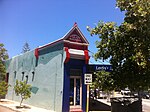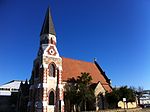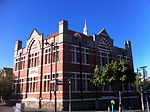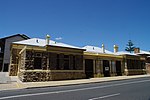Fremantle Prison, sometimes referred to as Fremantle Gaol or Fremantle Jail, is a former Australian prison and World Heritage Site in Fremantle, Western Australia. The six-hectare (15-acre) site includes the prison cellblocks, gatehouse, perimeter walls, cottages, and tunnels. It was initially used for convicts transported from Britain, but was transferred to the colonial government in 1886 for use for locally-sentenced prisoners. Royal Commissions were held in 1898 and 1911, and instigated some reform to the prison system, but significant changes did not begin until the 1960s. The government department in charge of the prison underwent several reorganisations in the 1970s and 1980s, but the culture of Fremantle Prison was resistant to change. Growing prisoner discontent culminated in a 1988 riot with guards taken hostage, and a fire that caused $1.8 million worth of damage. The prison closed in 1991, replaced by the new maximum-security Casuarina Prison.
The prison was administered by a comptroller general, sheriff, or director, responsible for the entire convict or prison system in Western Australia, and a superintendent in charge of the prison itself. Prison officers, known as warders in the 19th century, worked under stringent conditions until they achieved representation through the Western Australian Prison Officers' Union. Convicts were initially of good character as potential future colonists, but less desirable convicts were eventually sent. As a locally-run prison, Fremantle's population was generally short-sentenced white prisoners in the 1890s, with very few Aboriginal prisoners. By the late 20th century, most prisoners were serving longer sentences, a higher proportion of them were violent, and Aboriginal people were present in large numbers.
Prison life at Fremantle was extremely regulated. Meals were an important part of the day, eaten in the cells throughout the operational life of the prison. Convict or prisoner labour was used on public infrastructure works until around 1911; subsequently, only work inside the prison was allowed, though there was never enough to fully occupy the inmates. Punishments varied over the years, with flogging and time in irons eventually replaced by lengthening of sentences and deprivation of visitors or entertainment. More than 40 hangings were carried out at Fremantle Prison, which was Western Australia's only lawful place of execution between 1888 and 1984. Prominent escapees included Moondyne Joe, as well as John Boyle O'Reilly and six other Fenians in the 19th century, and Brenden Abbott in 1989. There have been various riots and other disturbances, with major riots causing damage in 1968 and 1988.
Since 1991, Fremantle Prison has been conserved as a recognised heritage site, and various restoration works have been undertaken. New uses have been found for some buildings within the prison, which has also become a significant tourist attraction. The process of obtaining World Heritage listing as part of the Australian Convict Sites submission focused historical interpretation and conservation efforts on the prison's convict era (1850 – 1886), at the expense of its more recent history, including Aboriginal prisoners held there.












